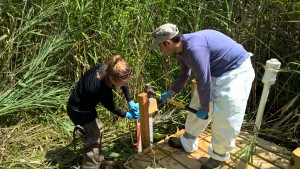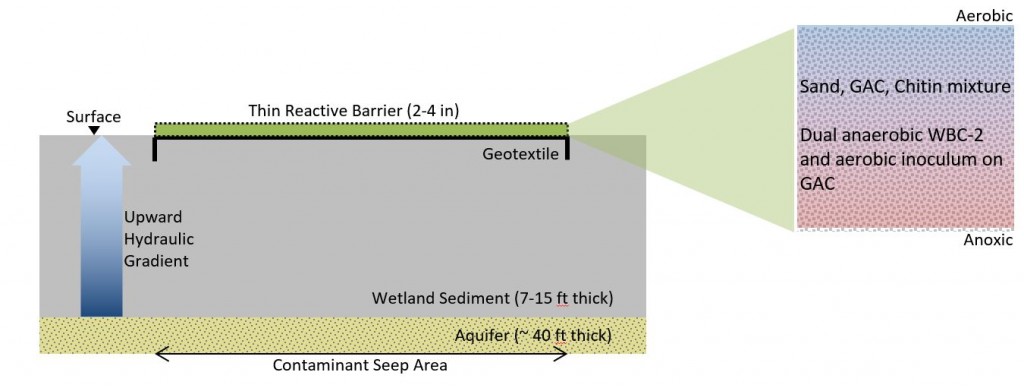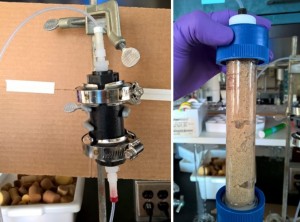Bio-barrier technology for the remediation of chlorobenzenes

Chlorobenzenes are a group of man-made organic chemicals. These chlorinated solvents are used in the manufacture of pesticides, degreasers, and rubber, as well as many other products. Although industrially useful, chlorobenzenes are known carcinogens; many of them can be found on the U.S. Center for Disease Control’s Hazardous Substance Priority List. Throughout the history of their production, hundreds of tons of chlorobenzenes have been released into the environment annually, contaminating thousands of sites in the U.S. and around the world. Since they are dense non-aqueous phase liquids (DNAPLs), chlorobenzenes sink to the bottom of groundwater aquifers after a spill or leak. The resulting underground “puddle” of concentrated chlorobenzenes represents a source of contamination that can last for decades as low levels of carcinogens slowly dissolve out into the groundwater.
The former Standard Chlorine of Delaware plant has been designated as a Superfund site by the U.S. Environmental Protection Agency (EPA). From 1966-2002, chlorobenzenes were manufactured there. During these three and half decades of commercial operation, two major spill events occurred. Hundreds of thousands of gallons of pure chlorobenzenes were accidentally released from storage tanks into the adjacent sediment and groundwater. These spills prompted the site’s eventual closure as well as clean-up efforts by the EPA. But despite remediation at the plant site, high levels of chlorobenzenes have been detected in groundwater flowing through adjacent wetlands and into the Delaware River watershed. This situation poses a long-term threat of chronic exposure for both human and animal populations.

The goal of our research is to investigate a novel, in situ bioremediation technology that can remove chlorobenzenes from slow-moving groundwater. The technology is a reactive bio-barrier that combines physical sorption processes with biological degradation. As groundwater discharges towards the surface at the contaminated site, it passes through both anaerobic and aerobic environments. Using activated carbon as a sorptive growth matrix, we will attempt to leverage the natural oxygen gradients present at the site to facilitate complete bio-mineralization of chlorobenzenes to harmless by-products. An anaerobic consortium of dehalogenating organisms would first transform high Cl-substituted chlorobenzenes to lower Cl-substituted chlorobenzenes. As water rises towards the surface, oxygen diffusing from the unsaturated root zone in sediment would then facilitate the aerobic mineralization of lower chlorobenzenes to H2O, H+, and Cl–.

In collaboration with Geosyntec Consultants and the United States Geological Survey, Bouwer group researchers are conducting both bench-scale laboratory investigations and applied field studies to determine the efficacy of this bio-barrier technology. Batch microcosms allow us to investigate specific degradation mechanisms, while long-term column studies simulate the full system. Our research brings together state-of-the-art microbial community analysis, analytical chemistry, and biological process design to gain a deeper understanding of the long-term function and efficacy of the bio-barrier system. Key variables such as redox conditions, dynamic hydraulic properties, and the weathering of barrier components will be evaluated to help determine function in the field. The results of this research will be applied directly to the Standard Chlorine of Delaware site and have the potential to transform current approaches to in situ treatment of an even broader group of halogenated organic solvents.
